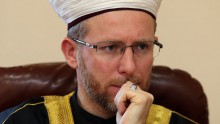Scholars assume that Germanic tribes inhabited this region. In fact, they probably left behind these two unique archeological sites: a burial place with ceremonial objects and a deep structure that the archeologists plan to examine more closely and identify.


A team of scientists and scholars from the joint archeological expedition of the Historical and Local Lore Museum in Vynnyky and the Ivan Franko National University in Lviv, headed by Associate Professor of Archeology Yaroslav Onyschuk discovered the burial site.
“Besides human remains, archaeologists found fragments of two glass vessels in the burial site. Nothing remotely resembling these artefacts has been found elsewhere in Ukraine. They also unearthed fragments of a three-layered horn comb, a bronze clasp (fibula), parts of a wooden box upholstered in bronze plates with decorative nails, and half of a token made of white glass paste. The Romans used such tokens to play board games,” says Olena Vasylko, Director of the Department of Architecture and Urban Development at the Lviv Regional State Administration.

Historians and researchers believe that a wealthy personality was buried here. They date the site to the beginning of the 3rd century AD, namely to the Wielbark culture; it flourished on the territory of modern Poland from the 1st to the 5th century AD and is associated with the Goths and related Germanic peoples.
“Some years ago, archeological teams began excavations in Kariv. Several interesting finds led to an archeological conference in Berlin, where leading European scientists examined and discussed the discovery. This dig is truly unique. As a matter of fact, our archaeologists unearth new objects and structures every year, so excavations will continue.” asserts Ihor Tymets, director of the Vynnyky Museum of History and Local Lore.
Explorations and excavations in and around Kariv began in 2017, when local ethnographers accidentally found an ancient sword and other metal items and delivered them to the museum in Vynnyky. Archaeologists realized that Germanic tribes used this territory to bury their dead, a discovery that has thrown an entirely different light on this region of western Ukraine.
“Kariv is the discovery of the century… and not only for Ukraine! In June 2017, we dug up, among other interesting artefacts, a bronze cauldron with attachments shaped like male heads. There are only three other similar discoveries elsewhere in the world. Moreover, we know very little about the peoples who inhabited these regions and their customs. Equally important, we assume that this is a group of people from the Middle Danube region who settled here for different reasons, namely because of the devastating Marcomannic Wars of 166-180.” stated the head of archeological team, Professor Yaroslav Onyschuk.

The Marcomannic Wars were a series of conflicts lasting over a dozen years from about 166 until 180 AD. These wars pitted the Roman Empire against the Germanic Marcomanni, Quadi, Sarmatian Iazyges tribes that inhabited both sides of the whole length of the Roman Empire’s northeastern European border, the river Danube. The wars against the Germans and Sarmatians occupied the major part of the reign of Roman emperor Marcus Aurelius
The excavations on the outskirts of Kariv are carried out by the Historical and Local Lore Museum in Vynnyky, the Department of Architecture and Urban Development of the Lviv Regional State Administration, the Department of Archeology and Special Branches of Historical Science, Ivan Franko National University in Lviv in partnership with the Institute of Archeology of the University of Rzeszów, Poland.








